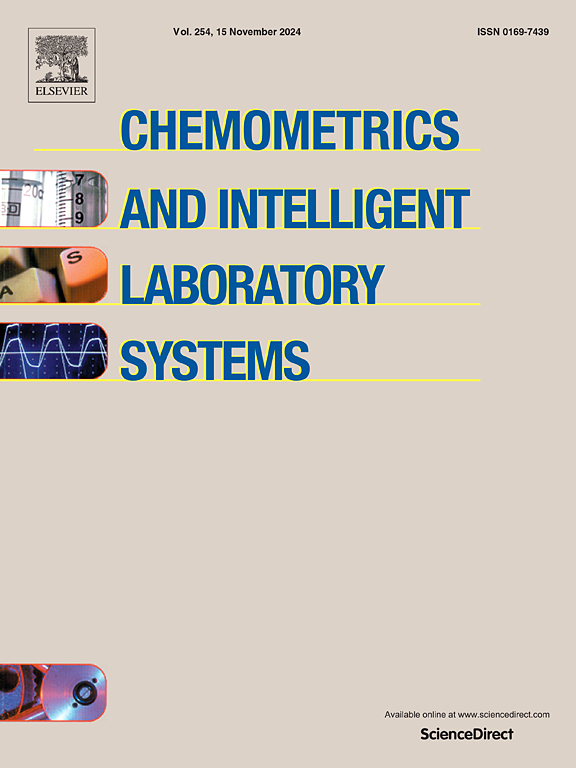Spectral investigation of aspartame and acesulfame utilizing PXRD, Raman, FTIR, and THz technologies
IF 3.8
2区 化学
Q2 AUTOMATION & CONTROL SYSTEMS
Chemometrics and Intelligent Laboratory Systems
Pub Date : 2025-04-15
DOI:10.1016/j.chemolab.2025.105408
引用次数: 0
Abstract
Artificial sweeteners, as a type of food additive, have vibration frequencies mostly concentrated in the terahertz (THz) band, which enables us to utilize THz technology to deeply analyze their molecular properties. To gain a more comprehensive understanding of the features of artificial sweeteners, this study specifically chose aspartame and acesulfame as representatives. Initially, we employed PXRD and Raman spectroscopy techniques to carry out a thorough examination and verification of the crystalline structure as well as the purity levels of these two synthetic sweeteners. Then, with the aid of Fourier transform infrared spectroscopy (FTIR) technology and terahertz time-domain spectroscopy (THz-TDS) system, the spectral characteristics of aspartame and acesulfame were precisely measured. Moreover, the crystal configurations of these two artificial sweeteners were simulated using solid-state density functional theory (DFT), and the simulation results were in good agreement with the experimental results, further validating the effectiveness of our research methods. Finally, using microfluidic chip technology, the THz spectral characteristics of aspartame and acesulfame in solution were determined, and were compared with their spectra in solid state. We found that the THz spectra of the two artificial sweeteners in solid and solution states have significant correlations. In addition, the research further elucidated that the THz spectrum of a substance dissolved in a solution exhibits a close correlation with its concentration within that solution. These findings provide new perspectives and value for our in-depth research on artificial sweeteners.
利用PXRD, Raman, FTIR和THz技术对阿斯巴甜和安赛蜜进行光谱研究
人工甜味剂作为一种食品添加剂,其振动频率主要集中在太赫兹(THz)波段,这使得我们可以利用太赫兹技术深入分析其分子特性。为了更全面地了解人工甜味剂的特点,本研究特别选择了阿斯巴甜和安赛蜜作为代表。最初,我们采用PXRD和拉曼光谱技术对这两种合成甜味剂的晶体结构和纯度水平进行了彻底的检查和验证。然后,借助傅里叶变换红外光谱(FTIR)技术和太赫兹时域光谱(THz-TDS)系统,精确测量了阿斯巴甜和安赛蜜的光谱特征。利用固体密度泛函理论(solid-state density functional theory, DFT)对这两种人工甜味剂的晶体构型进行了模拟,模拟结果与实验结果吻合较好,进一步验证了研究方法的有效性。最后,利用微流控芯片技术测定了阿斯巴甜和安赛蜜在溶液中的太赫兹光谱特征,并与它们在固态中的太赫兹光谱进行了比较。我们发现两种人工甜味剂在固溶状态下的太赫兹光谱具有显著的相关性。此外,研究进一步阐明了溶解在溶液中的物质的太赫兹光谱与其在该溶液中的浓度密切相关。这些发现为我们对人工甜味剂的深入研究提供了新的视角和价值。
本文章由计算机程序翻译,如有差异,请以英文原文为准。
求助全文
约1分钟内获得全文
求助全文
来源期刊
CiteScore
7.50
自引率
7.70%
发文量
169
审稿时长
3.4 months
期刊介绍:
Chemometrics and Intelligent Laboratory Systems publishes original research papers, short communications, reviews, tutorials and Original Software Publications reporting on development of novel statistical, mathematical, or computer techniques in Chemistry and related disciplines.
Chemometrics is the chemical discipline that uses mathematical and statistical methods to design or select optimal procedures and experiments, and to provide maximum chemical information by analysing chemical data.
The journal deals with the following topics:
1) Development of new statistical, mathematical and chemometrical methods for Chemistry and related fields (Environmental Chemistry, Biochemistry, Toxicology, System Biology, -Omics, etc.)
2) Novel applications of chemometrics to all branches of Chemistry and related fields (typical domains of interest are: process data analysis, experimental design, data mining, signal processing, supervised modelling, decision making, robust statistics, mixture analysis, multivariate calibration etc.) Routine applications of established chemometrical techniques will not be considered.
3) Development of new software that provides novel tools or truly advances the use of chemometrical methods.
4) Well characterized data sets to test performance for the new methods and software.
The journal complies with International Committee of Medical Journal Editors'' Uniform requirements for manuscripts.

 求助内容:
求助内容: 应助结果提醒方式:
应助结果提醒方式:


